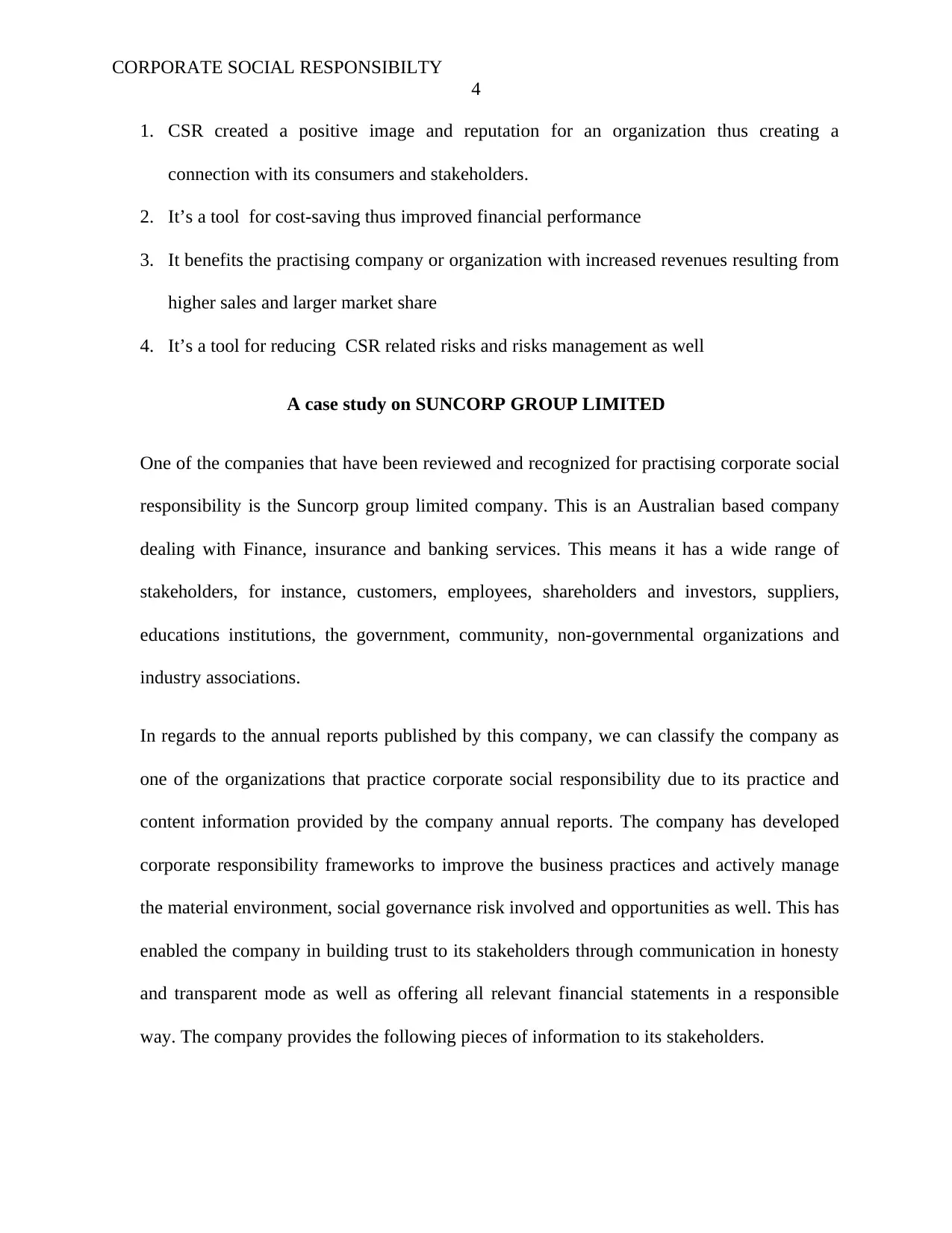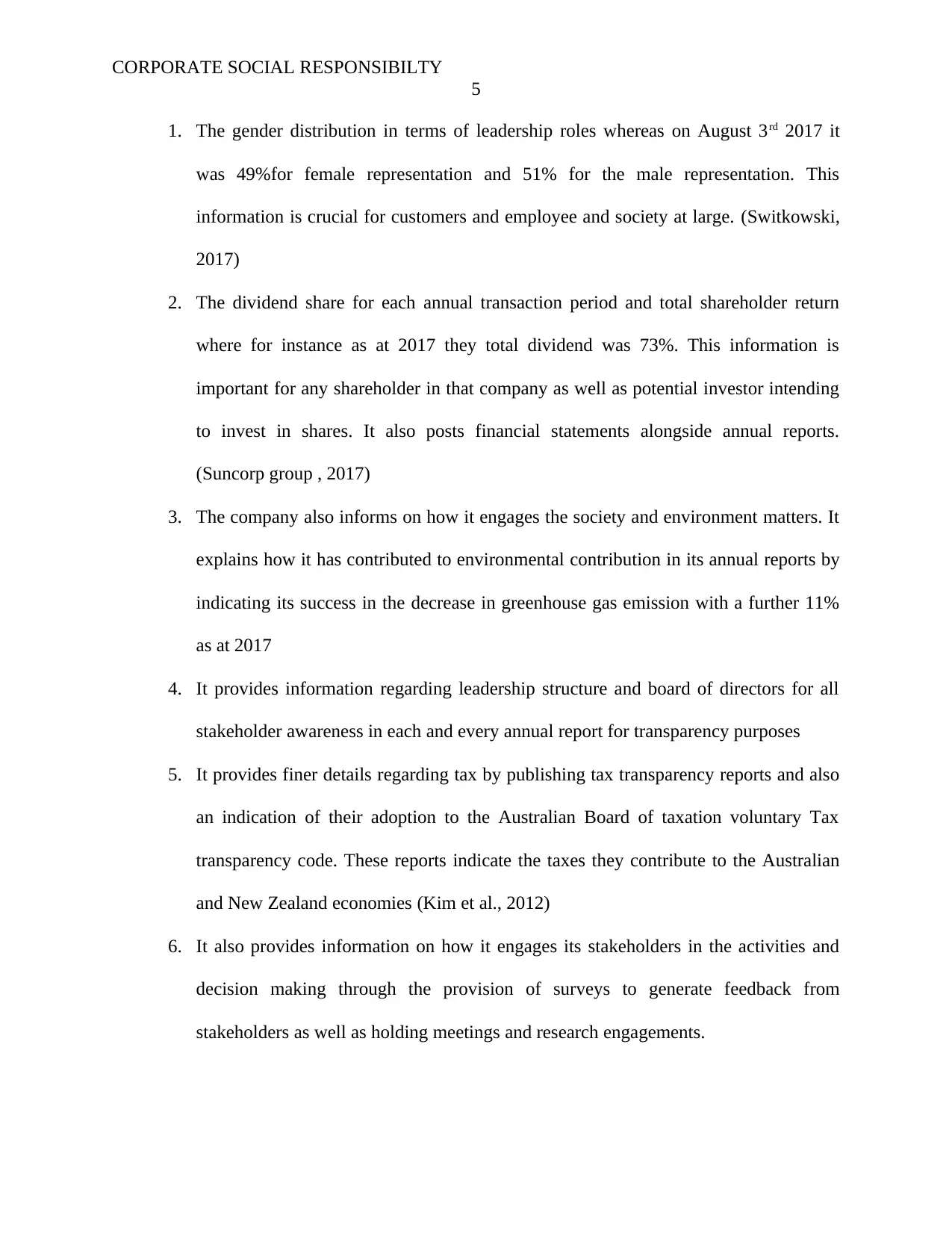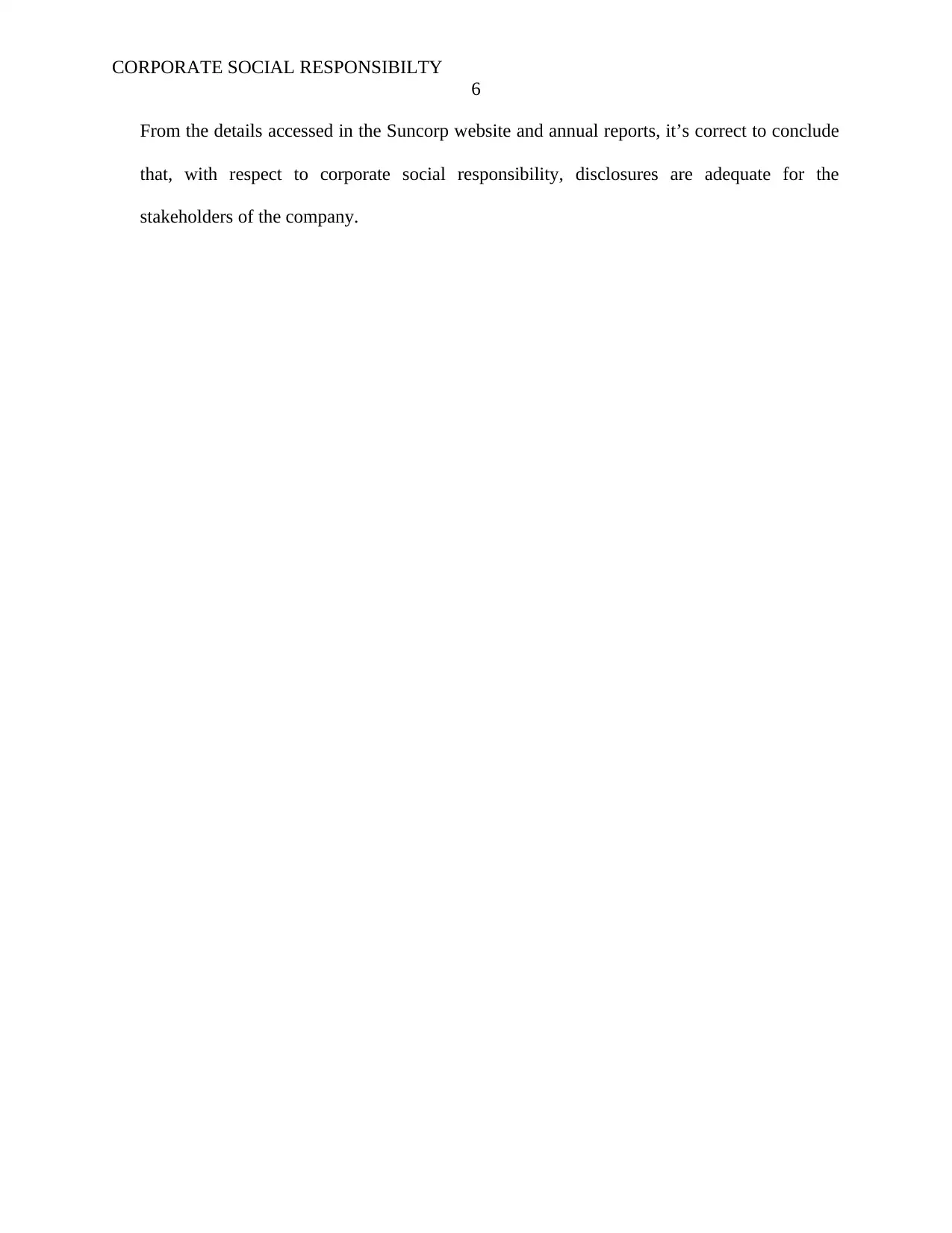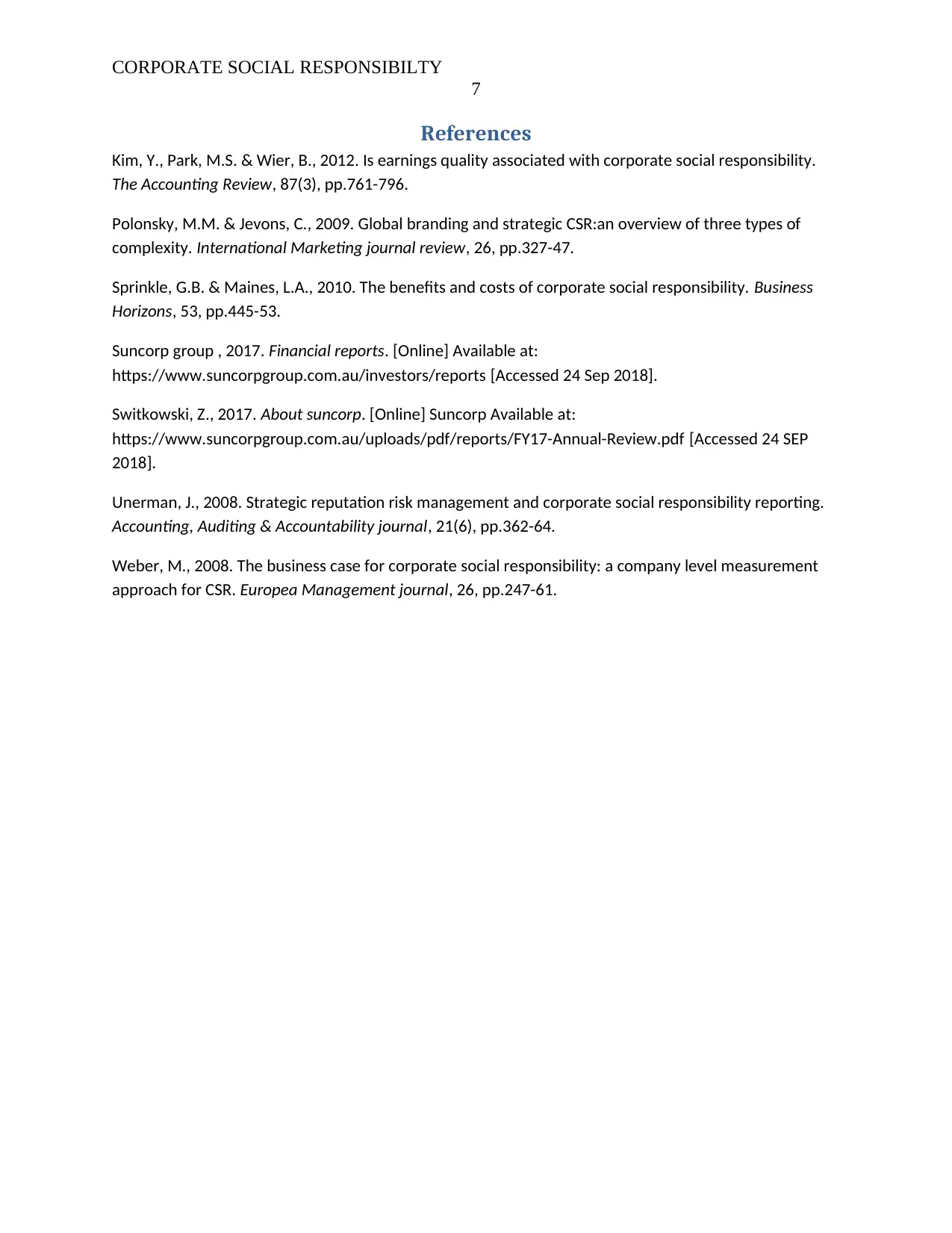Advanced Corporate Reporting ACC5CRE: Suncorp Group CSR Analysis
VerifiedAdded on 2023/06/04
|7
|1422
|191
Report
AI Summary
This report provides an analysis of Suncorp Group Limited's corporate social responsibility (CSR) practices. It defines CSR as a self-regulating business model that enhances accountability to stakeholders and society. The report highlights the increasing importance of CSR for reputation, stakeholder perception, and profitability. It discusses motivations for organizations to engage in CSR, such as employee retention, customer attraction, and recruitment benefits. The report emphasizes the positive impacts of CSR, including improved image, cost savings, increased revenues, and risk management. A case study of Suncorp Group Limited, an Australian finance, insurance, and banking company, demonstrates the company's commitment to CSR through its annual reports, which disclose information on gender distribution, dividend shares, environmental contributions, leadership structure, tax transparency, and stakeholder engagement. The report concludes that Suncorp's CSR disclosures are adequate for its stakeholders. Desklib provides access to this and other solved assignments for students.

CORPORATE SOCIAL RESPONSIBILTY
1
Name
Course
Lecturer
Date
1
Name
Course
Lecturer
Date
Paraphrase This Document
Need a fresh take? Get an instant paraphrase of this document with our AI Paraphraser

CORPORATE SOCIAL RESPONSIBILTY
2
Corporate social responsibility
In a business perspective, corporate social responsibility is defined as a self-regulating
business model that can be employed by a company or any organization to enhance
accountability to the company itself, to its relevant stakeholder and public as well. Corporate
social responsibility is a tool that business organizations employ to ensure consciousness in
relation to the impact they can have on all the dimensions and aspect of society that may include
economic, social and environmentally wise. Engaging and practice of corporate social
responsibility is one of the effective ways that organizations, both profit-making and non-profit
making ones enhance society and the environment at large to avoid contributing negatively to it.
“Corporate social responsibility (CSR) is an issue of growing interest, and the reporting of
socially responsible activity is becoming more prevalent as investors, customers, and other
stakeholders demand greater transparency about all aspects of the business. As the importance
placed by stakeholders on socially responsible behaviour has increased, the attitude toward CSR
has changed dramatically over the last few decades.
According to (Polonsky & Jevons, 2009), there is a need for organizations to be
considerate on the carefulness of the activities they undertake in a responsible manner as well as
understanding how their stakeholders these activities in general. This explains what an effective
corporate social responsibility means to a stakeholder, an investor or a customer. Reputation and
organization image is a key factor that each management should consider to protect. Different
activities relating to CSR have either a positive or negative impact on the corporate reputation on
different groups of stakeholders, and this can alter the perception they have regarding a certain
organization. Stakeholders’ perception is very significant when it comes to the success of an
organization. “Corporate social responsibility has the power to influence these perceptions,
2
Corporate social responsibility
In a business perspective, corporate social responsibility is defined as a self-regulating
business model that can be employed by a company or any organization to enhance
accountability to the company itself, to its relevant stakeholder and public as well. Corporate
social responsibility is a tool that business organizations employ to ensure consciousness in
relation to the impact they can have on all the dimensions and aspect of society that may include
economic, social and environmentally wise. Engaging and practice of corporate social
responsibility is one of the effective ways that organizations, both profit-making and non-profit
making ones enhance society and the environment at large to avoid contributing negatively to it.
“Corporate social responsibility (CSR) is an issue of growing interest, and the reporting of
socially responsible activity is becoming more prevalent as investors, customers, and other
stakeholders demand greater transparency about all aspects of the business. As the importance
placed by stakeholders on socially responsible behaviour has increased, the attitude toward CSR
has changed dramatically over the last few decades.
According to (Polonsky & Jevons, 2009), there is a need for organizations to be
considerate on the carefulness of the activities they undertake in a responsible manner as well as
understanding how their stakeholders these activities in general. This explains what an effective
corporate social responsibility means to a stakeholder, an investor or a customer. Reputation and
organization image is a key factor that each management should consider to protect. Different
activities relating to CSR have either a positive or negative impact on the corporate reputation on
different groups of stakeholders, and this can alter the perception they have regarding a certain
organization. Stakeholders’ perception is very significant when it comes to the success of an
organization. “Corporate social responsibility has the power to influence these perceptions,

CORPORATE SOCIAL RESPONSIBILTY
3
thereby contributing towards maximizing the earning potential of corporate reputation”
(Unerman, 2008)
For the recent past, stakeholders have given more attention to the issue regarding
corporate social responsibility and it’s due to this; we have been having many businesses and
organization stakeholders wanting to be associated with only the organizations that are deemed
to be socially responsible. Moreover, the companies, as well as the individual business, are
equating social responsibility with increased profitability. According to (Sprinkle & Maines,
2010) organizations and companies are being motivated to undertake socially responsible
behaviours and activities for some reasons which they can use as” window dressing”
opportunities to appease customers, stakeholders and potential investors to their firms. These
include:
1. To motivate and retains current employees
2. To enhance customer related motivations since corporate social responsibility
entices potential consumers to purchase organizations products and services
3. To enhance any potential benefits in relation to recruitment
The driving force for organizations to enhance corporate social responsibility is to entice and
encourage customers and all potential stakeholders for the above-mentioned benefits. On the
other hand, when the organizations manage to appease various stakeholder groups, it also enjoys
some positive effects resulting from the practice of cooperate social responsibility. This explains
why organizations are fast growing their concern on the aspect of corporate social responsibility.
According to (Weber, 2008) practising corporate social responsibility has in the long run been of
great importance and significance to the individual organizations in the following aspect:
3
thereby contributing towards maximizing the earning potential of corporate reputation”
(Unerman, 2008)
For the recent past, stakeholders have given more attention to the issue regarding
corporate social responsibility and it’s due to this; we have been having many businesses and
organization stakeholders wanting to be associated with only the organizations that are deemed
to be socially responsible. Moreover, the companies, as well as the individual business, are
equating social responsibility with increased profitability. According to (Sprinkle & Maines,
2010) organizations and companies are being motivated to undertake socially responsible
behaviours and activities for some reasons which they can use as” window dressing”
opportunities to appease customers, stakeholders and potential investors to their firms. These
include:
1. To motivate and retains current employees
2. To enhance customer related motivations since corporate social responsibility
entices potential consumers to purchase organizations products and services
3. To enhance any potential benefits in relation to recruitment
The driving force for organizations to enhance corporate social responsibility is to entice and
encourage customers and all potential stakeholders for the above-mentioned benefits. On the
other hand, when the organizations manage to appease various stakeholder groups, it also enjoys
some positive effects resulting from the practice of cooperate social responsibility. This explains
why organizations are fast growing their concern on the aspect of corporate social responsibility.
According to (Weber, 2008) practising corporate social responsibility has in the long run been of
great importance and significance to the individual organizations in the following aspect:
⊘ This is a preview!⊘
Do you want full access?
Subscribe today to unlock all pages.

Trusted by 1+ million students worldwide

CORPORATE SOCIAL RESPONSIBILTY
4
1. CSR created a positive image and reputation for an organization thus creating a
connection with its consumers and stakeholders.
2. It’s a tool for cost-saving thus improved financial performance
3. It benefits the practising company or organization with increased revenues resulting from
higher sales and larger market share
4. It’s a tool for reducing CSR related risks and risks management as well
A case study on SUNCORP GROUP LIMITED
One of the companies that have been reviewed and recognized for practising corporate social
responsibility is the Suncorp group limited company. This is an Australian based company
dealing with Finance, insurance and banking services. This means it has a wide range of
stakeholders, for instance, customers, employees, shareholders and investors, suppliers,
educations institutions, the government, community, non-governmental organizations and
industry associations.
In regards to the annual reports published by this company, we can classify the company as
one of the organizations that practice corporate social responsibility due to its practice and
content information provided by the company annual reports. The company has developed
corporate responsibility frameworks to improve the business practices and actively manage
the material environment, social governance risk involved and opportunities as well. This has
enabled the company in building trust to its stakeholders through communication in honesty
and transparent mode as well as offering all relevant financial statements in a responsible
way. The company provides the following pieces of information to its stakeholders.
4
1. CSR created a positive image and reputation for an organization thus creating a
connection with its consumers and stakeholders.
2. It’s a tool for cost-saving thus improved financial performance
3. It benefits the practising company or organization with increased revenues resulting from
higher sales and larger market share
4. It’s a tool for reducing CSR related risks and risks management as well
A case study on SUNCORP GROUP LIMITED
One of the companies that have been reviewed and recognized for practising corporate social
responsibility is the Suncorp group limited company. This is an Australian based company
dealing with Finance, insurance and banking services. This means it has a wide range of
stakeholders, for instance, customers, employees, shareholders and investors, suppliers,
educations institutions, the government, community, non-governmental organizations and
industry associations.
In regards to the annual reports published by this company, we can classify the company as
one of the organizations that practice corporate social responsibility due to its practice and
content information provided by the company annual reports. The company has developed
corporate responsibility frameworks to improve the business practices and actively manage
the material environment, social governance risk involved and opportunities as well. This has
enabled the company in building trust to its stakeholders through communication in honesty
and transparent mode as well as offering all relevant financial statements in a responsible
way. The company provides the following pieces of information to its stakeholders.
Paraphrase This Document
Need a fresh take? Get an instant paraphrase of this document with our AI Paraphraser

CORPORATE SOCIAL RESPONSIBILTY
5
1. The gender distribution in terms of leadership roles whereas on August 3rd 2017 it
was 49%for female representation and 51% for the male representation. This
information is crucial for customers and employee and society at large. (Switkowski,
2017)
2. The dividend share for each annual transaction period and total shareholder return
where for instance as at 2017 they total dividend was 73%. This information is
important for any shareholder in that company as well as potential investor intending
to invest in shares. It also posts financial statements alongside annual reports.
(Suncorp group , 2017)
3. The company also informs on how it engages the society and environment matters. It
explains how it has contributed to environmental contribution in its annual reports by
indicating its success in the decrease in greenhouse gas emission with a further 11%
as at 2017
4. It provides information regarding leadership structure and board of directors for all
stakeholder awareness in each and every annual report for transparency purposes
5. It provides finer details regarding tax by publishing tax transparency reports and also
an indication of their adoption to the Australian Board of taxation voluntary Tax
transparency code. These reports indicate the taxes they contribute to the Australian
and New Zealand economies (Kim et al., 2012)
6. It also provides information on how it engages its stakeholders in the activities and
decision making through the provision of surveys to generate feedback from
stakeholders as well as holding meetings and research engagements.
5
1. The gender distribution in terms of leadership roles whereas on August 3rd 2017 it
was 49%for female representation and 51% for the male representation. This
information is crucial for customers and employee and society at large. (Switkowski,
2017)
2. The dividend share for each annual transaction period and total shareholder return
where for instance as at 2017 they total dividend was 73%. This information is
important for any shareholder in that company as well as potential investor intending
to invest in shares. It also posts financial statements alongside annual reports.
(Suncorp group , 2017)
3. The company also informs on how it engages the society and environment matters. It
explains how it has contributed to environmental contribution in its annual reports by
indicating its success in the decrease in greenhouse gas emission with a further 11%
as at 2017
4. It provides information regarding leadership structure and board of directors for all
stakeholder awareness in each and every annual report for transparency purposes
5. It provides finer details regarding tax by publishing tax transparency reports and also
an indication of their adoption to the Australian Board of taxation voluntary Tax
transparency code. These reports indicate the taxes they contribute to the Australian
and New Zealand economies (Kim et al., 2012)
6. It also provides information on how it engages its stakeholders in the activities and
decision making through the provision of surveys to generate feedback from
stakeholders as well as holding meetings and research engagements.

CORPORATE SOCIAL RESPONSIBILTY
6
From the details accessed in the Suncorp website and annual reports, it’s correct to conclude
that, with respect to corporate social responsibility, disclosures are adequate for the
stakeholders of the company.
6
From the details accessed in the Suncorp website and annual reports, it’s correct to conclude
that, with respect to corporate social responsibility, disclosures are adequate for the
stakeholders of the company.
⊘ This is a preview!⊘
Do you want full access?
Subscribe today to unlock all pages.

Trusted by 1+ million students worldwide

CORPORATE SOCIAL RESPONSIBILTY
7
References
Kim, Y., Park, M.S. & Wier, B., 2012. Is earnings quality associated with corporate social responsibility.
The Accounting Review, 87(3), pp.761-796.
Polonsky, M.M. & Jevons, C., 2009. Global branding and strategic CSR:an overview of three types of
complexity. International Marketing journal review, 26, pp.327-47.
Sprinkle, G.B. & Maines, L.A., 2010. The benefits and costs of corporate social responsibility. Business
Horizons, 53, pp.445-53.
Suncorp group , 2017. Financial reports. [Online] Available at:
https://www.suncorpgroup.com.au/investors/reports [Accessed 24 Sep 2018].
Switkowski, Z., 2017. About suncorp. [Online] Suncorp Available at:
https://www.suncorpgroup.com.au/uploads/pdf/reports/FY17-Annual-Review.pdf [Accessed 24 SEP
2018].
Unerman, J., 2008. Strategic reputation risk management and corporate social responsibility reporting.
Accounting, Auditing & Accountability journal, 21(6), pp.362-64.
Weber, M., 2008. The business case for corporate social responsibility: a company level measurement
approach for CSR. Europea Management journal, 26, pp.247-61.
7
References
Kim, Y., Park, M.S. & Wier, B., 2012. Is earnings quality associated with corporate social responsibility.
The Accounting Review, 87(3), pp.761-796.
Polonsky, M.M. & Jevons, C., 2009. Global branding and strategic CSR:an overview of three types of
complexity. International Marketing journal review, 26, pp.327-47.
Sprinkle, G.B. & Maines, L.A., 2010. The benefits and costs of corporate social responsibility. Business
Horizons, 53, pp.445-53.
Suncorp group , 2017. Financial reports. [Online] Available at:
https://www.suncorpgroup.com.au/investors/reports [Accessed 24 Sep 2018].
Switkowski, Z., 2017. About suncorp. [Online] Suncorp Available at:
https://www.suncorpgroup.com.au/uploads/pdf/reports/FY17-Annual-Review.pdf [Accessed 24 SEP
2018].
Unerman, J., 2008. Strategic reputation risk management and corporate social responsibility reporting.
Accounting, Auditing & Accountability journal, 21(6), pp.362-64.
Weber, M., 2008. The business case for corporate social responsibility: a company level measurement
approach for CSR. Europea Management journal, 26, pp.247-61.
1 out of 7
Related Documents
Your All-in-One AI-Powered Toolkit for Academic Success.
+13062052269
info@desklib.com
Available 24*7 on WhatsApp / Email
![[object Object]](/_next/static/media/star-bottom.7253800d.svg)
Unlock your academic potential
Copyright © 2020–2025 A2Z Services. All Rights Reserved. Developed and managed by ZUCOL.




